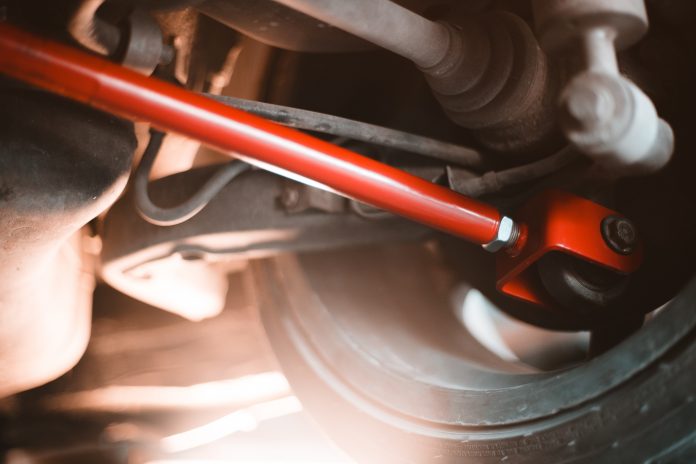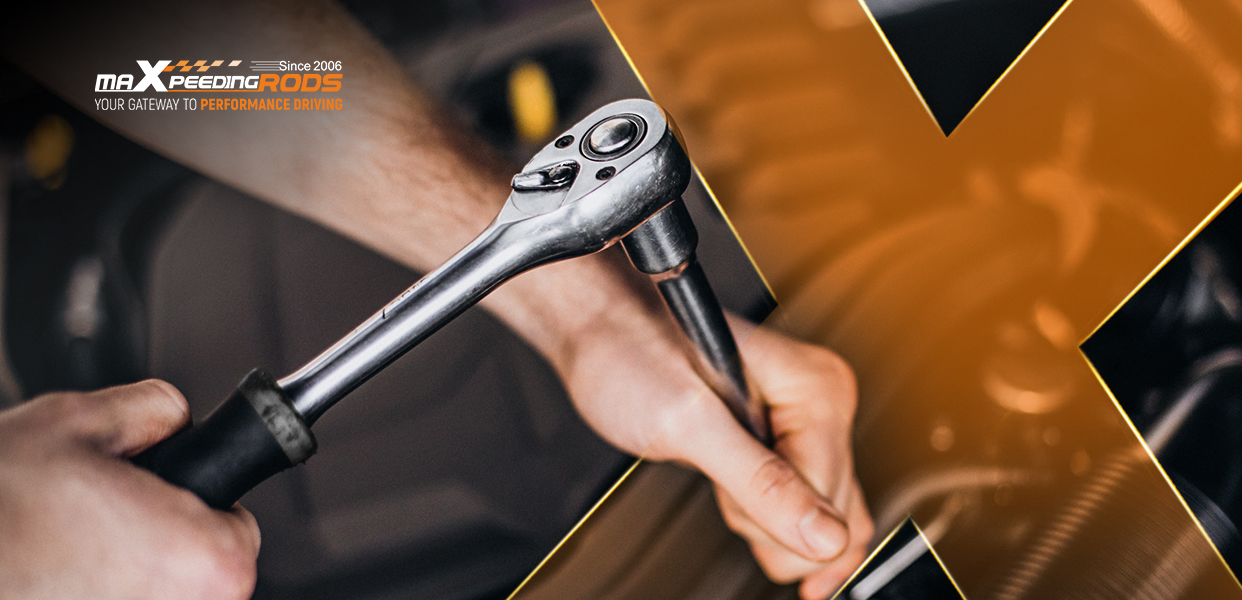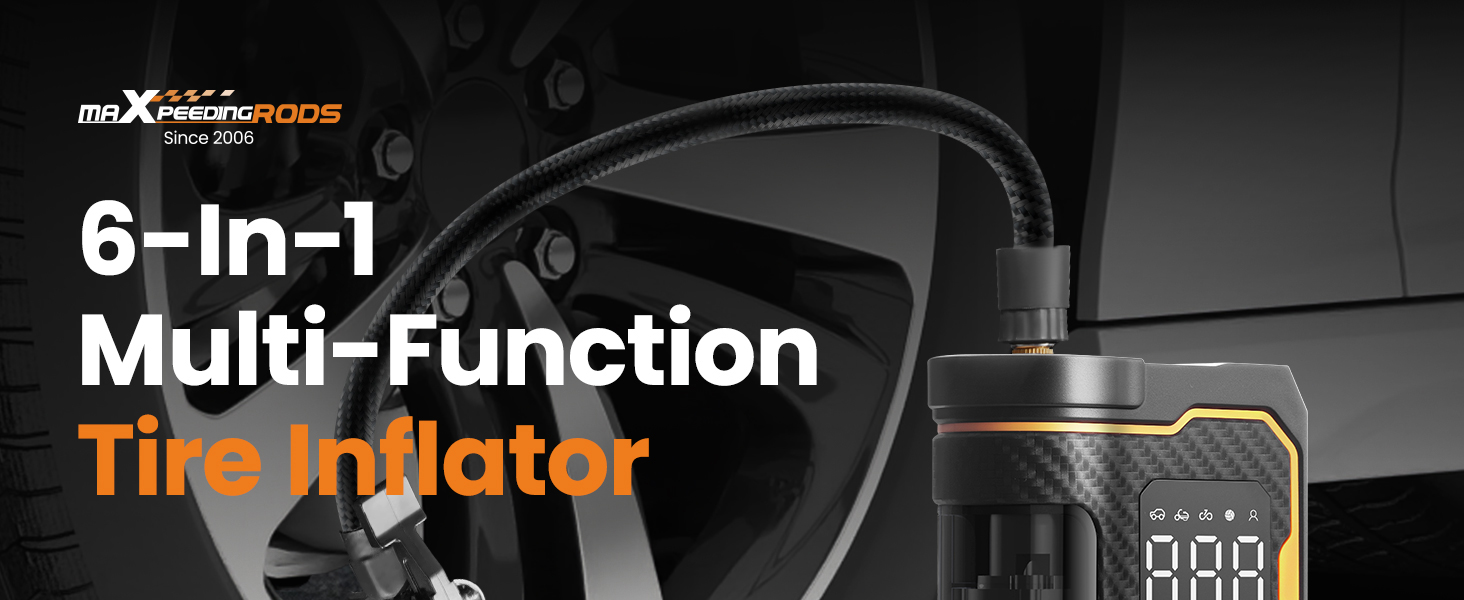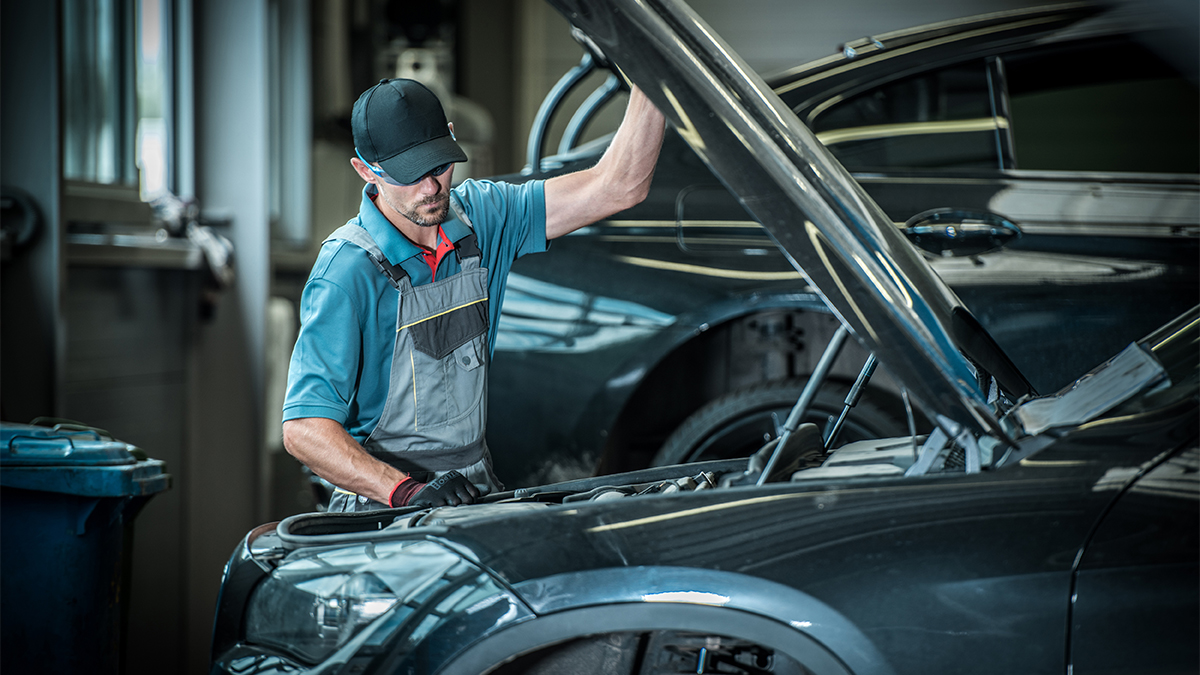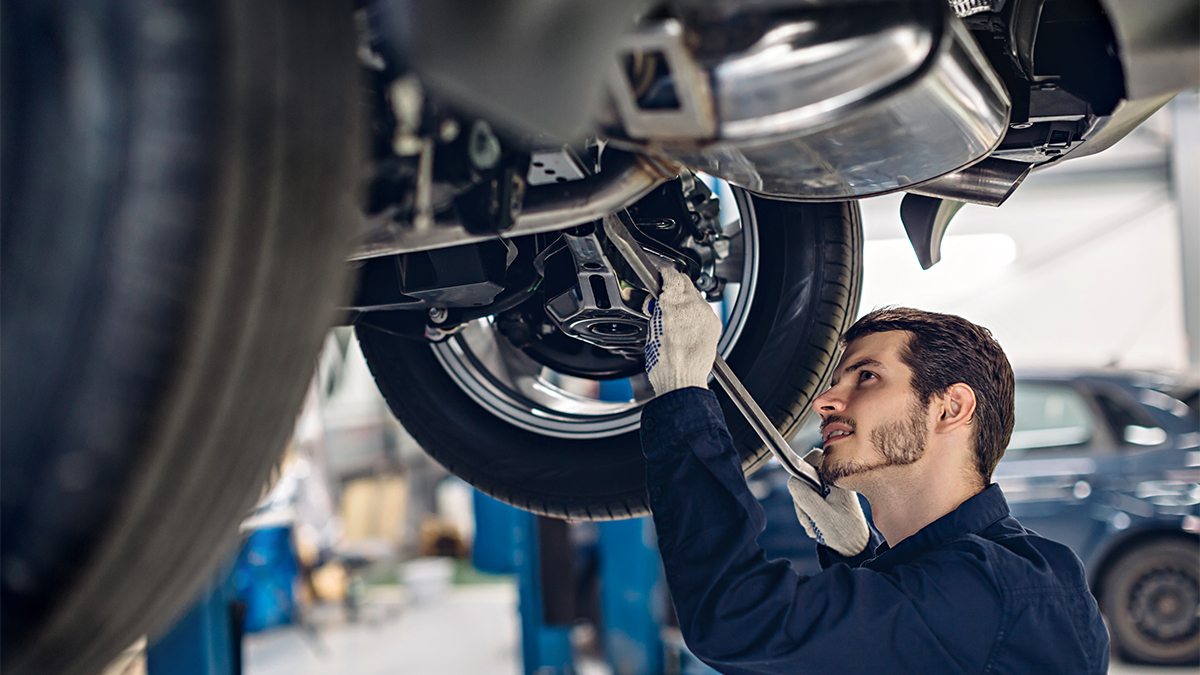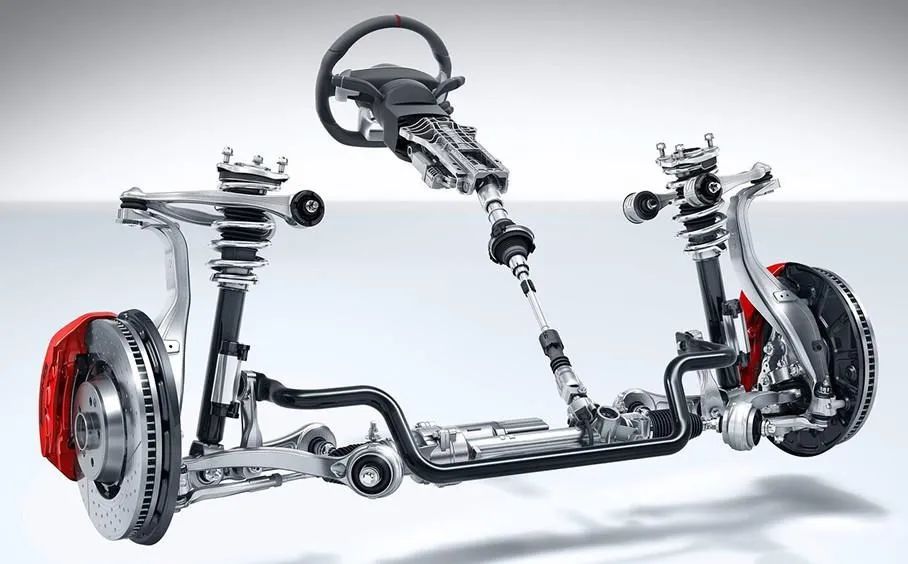Buying a control arm for your car can sometimes be a daunting and confusing task. At maxpeedingrods.com, it is our mission to make that task as easy and painless as possible. This Buyer’s Guide is designed to answer any questions you may have during your search for the right control arms for your car, and how to buy control arms on MaXpeedingRods website.
WHAT ARE CONTROL ARMS?
Control arms, sometimes called “A arms,” are the core of your front suspension system. In simple terms, control arms are the link that connects your front wheels to your car. One end connects to the wheel assembly and the other end connects to the frame or chassis of your car.
The upper control arm connects to the uppermost area of the steering knuckle or spindle and the lower control arm connects to the lower most area of the knuckle or spindle, with both arms then attaching to the frame of the car.
The most common types of control arm suspensions are:
• Control arm type suspension a.k.a double wishbone
• Strut type suspension a.k.a. the McPherson strut
Strut type designs have a lower control arm but no upper control arm. In strut designs, the strut becomes the upper control arm and is sometimes connected directly to the spindle or the lower control arm.
WHAT IS THE FUNCTION OF CONTROL ARMS?
Control arms may not be common terms for many vehicle owners. You may have never even heard of them, but it is a critical component of your vehicle’s suspension system that allows your tires to smoothly go up and down in a controlled fashion. Without it, your ride probably wouldn’t be very enjoyable or safe.
Most vehicles use either one or two control arms per wheel, on the front, and sometimes on the rear suspension too. Many front-wheel-drive vehicles only use a lower control arm, while trucks and SUVs often have both an upper and a lower control arm. A control arm connects the wheel hub and steering knuckle to the frame of the vehicle. They are typically equipped with bushings on the frame side of the vehicle and a ball joint on the wheel side to allow flex and controlled movement according to road conditions and steering input from the driver. Control arms allow wheels to move up and down while preventing forward and rearward movement.
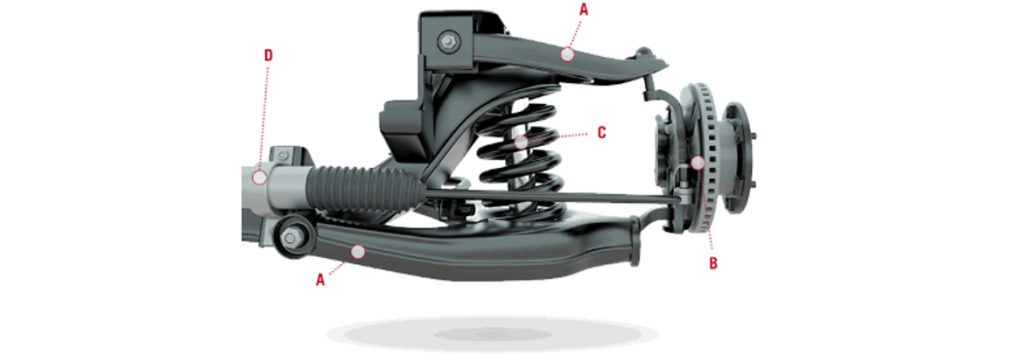
HOW DO CONTROL ARMS WORK?
A – Each control arm is connected to the vehicle frame with two control arm bushings. These bushings allow the control arms to rotate on the bushing axis, thus allowing the other end of the arm to go up and down.
B – The opposite end of the control arm is attached to a steel spindle. The spindle is what the front wheel is bolted onto. On non-strut equipped vehicles, the spindle is attached to both the upper and lower control arms with a ball joint. The ball joint is a steel ball enclosed in a steel socket that allows the spindle and front wheel to rotate left and right and allows the wheels to move up and down following the road surface.
C – Sandwiched between the control arm and vehicle frame, positioned in a spring socket, is a heavy steel coil spring that supports the weight of your vehicle and provides a cushion against bumps.
D – To combine the two opposite motions on each end of the control arm, the arms are tied on the frame side to pivot up and down on the control arm bushings. On the opposite end, the control arm is tied to the spindle and front wheel with upper and lower ball joints. The coil spring supports the weight of the car and dampens the shock of road surfaces.
To ensure that the control arms, bushings, and ball joints are in perfect alignment, some control arms include adjustable attachment points at the frame. When necessary, a mechanic can align the front end and keep your car driving straight down the road and prevent uneven tire wear.
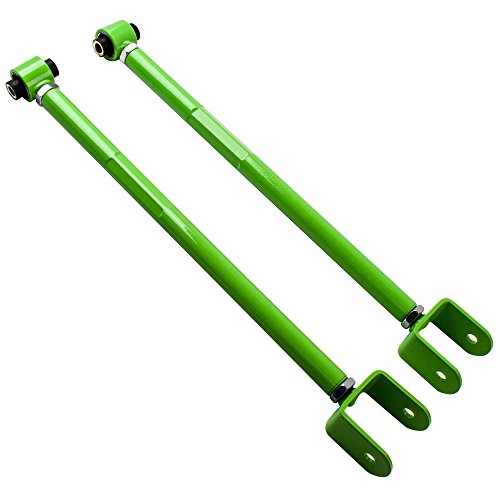
HOW TO CHOOSE CONTROL ARMS?
When control arms go bad you’re going to know it. The car may squeak or make a knocking sound whenever you drive over a bump, or it may pull to one side or the other. You also may notice the tires wearing unevenly. Control arm failure happens due to normal wear and tear, or the bushing on the control arm may have become compromised.
When shopping for your new control arm assembly you’ll want to look for sturdy enough materials at a price within your budget. This part endures quite a bit of stress so you want a durable product.
To make sure you get a good quality control arm assembly, you need to consider the following points:
• Decide on materials. Cast aluminum control arm assemblies are lightweight and corrosion-resistant, however they tend to buckle more easily over rough potholes. Cast iron arms are exceptionally strong and are typically wishbone-shaped. Stamped steel arms were typically used on older cars. They’re less expensive but can easily fall prey to rust.
• Look for OEM (Original Equipment Manufacturer) -comparable pieces if you’re going with aftermarket parts. High-quality aftermarket parts can perform to the same level as OEM parts, just make sure to buy from a reputable seller.
• Choose a control arm assembly that is powder coated or otherwise treated for corrosion resistance.

WHY BUY CONTROL ARMS AT MAXPEEDINGRODS?
- All MaXpeedingRods control arms are made from high-quality materials to ensure durability and longevity.
- All our control arms are accurately cast/stamped/welded to ensure they provide correct fitment and a safe and enjoyable ride.
- All MaXpeedingRods meet or exceed OEM standards and rely on rigorous control to ensure they are shipped to you without any defects and ready to be installed on your vehicle restoring proper steering geometry and evening out tire wear.
- All MaXPeeingRods are finished with high-quality paints and finishes to ensure they remain rust-free for years to come
- All our control arms include the required hardware and/or ball joints for an easy, quick and complete install
- MaXpeedingRods offers a seamless online shopping experience and the streamlined e-commerce interface makes it easy for you to find just the control arms you want.
- We offer a very wide range of control arms for all kinds of vehicles. From passenger cars to off-road vehicles or even dirt, drift, or track racing vehicles.
- Professional installation of our control arms is highly recommended as they do not come with novice-friendly instructions.
- For professional assistance with choosing the correct control arms for your vehicle, you can reach out to us via our website www.maxpeedingrods.com. (Use code:Blog to get 10% discount)
WHAT ARE THE SYMPTOMS OF A BAD OR FAILING CONTROL ARM?
Over time, the bushings or ball joints on the control arm wear out and can cause all sorts of problems. Usually, a problematic control arm assembly will produce a few symptoms that can alert the driver of a potential problem that should be addressed as soon as possible. Ignoring a faulty control arm is not wise as it can compromise the safety of your vehicle, you and your passengers.
1. Steering wheel vibration
One of the first symptoms commonly associated with bad control arms is steering wheel vibrations. If the bushings or ball joints in the control arm become excessively worn it can cause wheel shimmy, which may cause vibrations that may be felt in the wheel. The vibrations may increase as you accelerate and smoothen out once you are traveling at speed.
2. Steering wandering
Another symptom commonly associated with bad or failing control arm assembly is steering wandering. Excessively worn ball joints or bushings can cause the vehicle’s steering alignment to shift, which may cause the steering to pull to the left or right when traveling down the road. This will require constant correction from the driver in order to steer the vehicle straight.
3. Clunking noises
Clunking noises are another symptom of possible problems with the control arms on a vehicle. If the bushings or ball joints develop excessive play or looseness, this can cause them to knock when driving over road imperfections. The clunking sound will continuously get louder as the component wears further or until it eventually breaks. This is a scenario that you want to avoid at all costs because a broken control arm or ball joint will result in a loss of control over your vehicle and can result in serious injury or even death.
HOW TO INSTALL CONTROL ARMS IN A CAR?
If the control arm is damaged due to impact, or if the bushings and/or ball joints need replacement due to wear, it is more time and cost-effective to replace the entire arm as it generally comes complete with new bushings and ball joints.
Step 1: Loosen your wheel nuts or bolts and raise your vehicle. Use jacks stands and wheel chocks and only get under your vehicle once you are 100% certain it’s safe to do so.
Step 2: Unbolt the ball joint from the hub and the control arm. Depending on the location and type of your suspension you may need different tools to do unbolt the control arm. You will need to unbolt the control arm from both the frame and the ball joint. Removing the ball joint starts on the wheel hub side of the joint and will in many cases require a ball joint separator. Once you have removed the bolts holding the ball joint to the wheel hub, stick a ball joint separator between the hub and the joint. Hit the separator with a hammer. Depending on the amount of rust and vehicle age and mileage the separation may take quite a bit of force. Be patient and hit the separator with reasonable strength consistently until the hub and joint are separated. Once this is done you can unbolt the ball joint from the control arm and remove it.
Step 3: Unbolt the control arm from the frame. Removing the bolts and nuts that hold the control arm to the frame will often require two wrenches, one to hold the bolt in place and the other to unscrew the nut. The bots may be stuck or seized from rust on vehicles with high mileages or vehicles that are driven on roads with a lot of snow. An impact gun can be a very helpful tool in this scenario. Make sure to soak the bolts with penetrating oil to help loosen the rust. Do not force the bolts as breaking them can make control arm replacement an absolute nightmare.
Step 4: Remove the control arm and install a new one. Removing the old control arm may require some force and wiggling to get it out. It may also require loosening other components of the suspension to actually get it out, this is the case most often on modern vehicles with complex multi-link suspension setups or all-wheel-drive. Once the control arm is out, install the new arm and new ball joint in the reverse order of the removal.
Ensure that you have the wheel alignment checked and restored after any suspension repairs.
